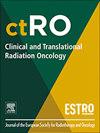Online CBCT-based adaptive radiation with reduced PTV margins for prostate cancer: Does reference plan comparison tell the whole story?
IF 2.7
3区 医学
Q3 ONCOLOGY
引用次数: 0
Abstract
Background
Online adaptive radiation (ART) is a novel treatment approach that allows for a new daily treatment plan based on cone beam CT (CBCT) imaging. This daily adaptation facilitates precise tumor and organ-at-risk (OAR) localization and minimizes the impact of interfractional motion, allowing for planning target volume (PTV) margin reduction. Isotropic PTV margins for localized non-stereotactic adaptive prostate radiation performed on an ETHOS linear accelerator with HyperSight have been reduced from standard 7 mm to 5 mm. This study assesses the impact of margin reduction by evaluating the dose metrics of patient reference plans, as well as daily treated plans, for 7 mm vs 5 mm PTV margins.
Methods
Patients with prostate cancer receiving moderately hypofractionated adaptive radiation were initially treated with a 7 mm PTV margin (n = 10). This retrospective study generated 5 mm PTV margin treatment plans (n = 10) for these patients for comparison. In addition, a full adaptive 20 fraction treatment course was simulated with margin reduction to identify differences not recognized with reference plan comparison alone.
Results
Bladder V40.8 and V48.6 but not V60 were significantly reduced in 5 mm treatment plans compared to 7 mm treatment plans. However, when daily treated plan data was examined bladder V60 was lower for the 5 mm PTV case. Similarly, rectum doses V24.6-V57 but not V60 were significantly reduced in 5 mm PTV margin treatment plans. Further differences were identified when looking at the daily treated plan data as opposed to simply comparing reference plans.
Significance
In the era of online ART, with significant data available, such as daily treated plan dosimetry, analysis of reference plans alone may not be sufficient. PTV margin reduction, made possible due to the use of online ART, reduced the volume of bladder and rectum receiving <60 Gy, which may reduce toxicity and secondary malignancy risk.
基于cbct的在线自适应放疗减少前列腺癌的PTV边缘:参考方案比较是否说明了全部情况?
背景线自适应放射(ART)是一种新的治疗方法,它允许基于锥形束CT (CBCT)成像的新的日常治疗计划。这种日常适应有助于精确定位肿瘤和危险器官(OAR),并最大限度地减少分节间运动的影响,从而规划目标体积(PTV)边缘缩小。在ETHOS线性加速器和HyperSight上进行的局部非立体定向适应性前列腺放疗的各向同性PTV边缘从标准的7毫米减少到5毫米。本研究通过评估患者参考计划的剂量指标,以及每日治疗计划,对7毫米和5毫米PTV切缘进行评估,以评估切缘减少的影响。方法接受中度低分割适应性放射治疗的前列腺癌患者最初采用7 mm PTV切缘(n = 10)进行治疗。本回顾性研究为这些患者制定了5 mm PTV切缘治疗方案(n = 10)进行比较。此外,模拟了一个完整的自适应20分治疗过程,减少了边际,以识别单独参考方案比较无法识别的差异。结果5 mm组膀胱V40.8、V48.6较7 mm组明显降低,V60无显著差异。然而,当检查每日治疗计划数据时,5mm PTV病例的膀胱V60较低。同样,在5mm PTV切缘治疗方案中,直肠剂量V24.6-V57而非V60显著降低。当查看每日处理的计划数据而不是简单地比较参考计划时,进一步的差异被确定。在网上抗逆转录病毒治疗的时代,有大量的可用数据,如每日治疗计划剂量测定,单独分析参考计划可能是不够的。由于在线ART的使用,PTV切缘减小,膀胱和直肠接受60 Gy的体积减小,这可能降低毒性和继发恶性肿瘤的风险。
本文章由计算机程序翻译,如有差异,请以英文原文为准。
求助全文
约1分钟内获得全文
求助全文
来源期刊

Clinical and Translational Radiation Oncology
Medicine-Radiology, Nuclear Medicine and Imaging
CiteScore
5.30
自引率
3.20%
发文量
114
审稿时长
40 days
 求助内容:
求助内容: 应助结果提醒方式:
应助结果提醒方式:


